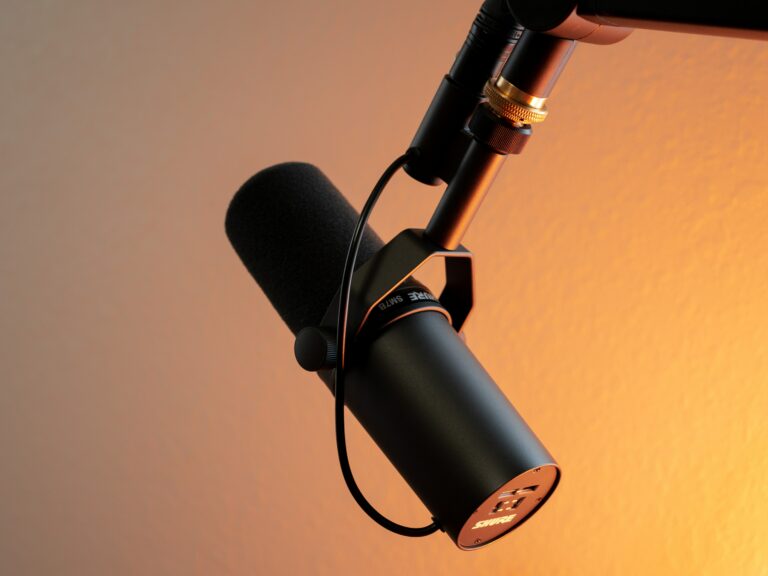Are you looking to supercharge your show with the best microphones for podcasting? Are you after an omnidirectional podcasting microphone? Or how about a condenser microphone or even a shotgun podcasting microphone? There are many elements to consider when picking the best podcasting microphone for your recording because;
For every podcast, you need to record your voice / your guest’s voice. So, you are going to need a microphone. Now, there is a huge range of ways you can record your voice and a huge range of quality that comes with these options. But if you want to supercharge your show with the best microphones for podcasting, we are going to explain below what it all means so you can make a sound choice and a choice within your budget.
What are the best microphones for podcasting and why are they important?
Microphones, also known as audio recording devices, are used to record and hear sounds, such as voices and music. They can be used to record television shows, radio broadcasts, podcasts, and YouTube videos. Microphones can either be wired or wireless. Wired microphones are typically placed on a stand and require a power source. Wireless microphones rely on battery power to function and connect to portable devices via Bluetooth technology.
A good microphone for podcasting is one that has features that allow you to achieve high-quality recordings without having to worry about your equipment not working properly because it’s plugged in all day long.
The truth is that excellent audio quality comes from how well the microphone’s condenser elements work together to pick up sound waves from your voice or music through the use of an earpiece with a cable attached directly into your receiver (or speakers). A good microphone will pick up these waves easily so that you can understand what your audience is saying while you’re talking.
The different types of microphones available on the market, but if you want to supercharge your show with the best microphones for podcasting we will help you work out which ones are best suited for podcasting.
Podcasting is a popular audio medium for recording short, easily-listened-to audio episodes. Using podcasting software can quickly make your voice heard in any digital environment.
The term “podcast” has become increasingly popular over recent years and has been embraced by listeners to hear stories through audio narratives. Some podcasts have been produced with professional studios capable of recording high-quality audio tracks for broadcast; others have been produced entirely in-house with no need for a studio at all.
There are currently many different types of microphones available on the market today, but you will often hear terms like shotgun mics or condenser mics used interchangeably when referring specifically to microphone types within this article (although each effect will be described separately below). There are also other terms used commonly when describing specifically mics that aren’t used in this article (e.g., cardioid, omnidirectional).
What microphone elements help attain optimal recording quality.
The microphone is the most important tool you have at your disposal when it comes to podcasting. The quality of your voice, your voice’s ability to convey important information, and anything else you want to say can be lost in the harsh environment of a poorly constructed microphone. Knowing how to set up a microphone and where to place it on a recording are both important parts of podcasting.
Different microphones work well for different types of podcasts. So, if you’re someone who uses a lot of different styles for podcasting, then there may be different microphones that work best for you.
The best way to start looking at microphones is by browsing audio equipment stores online or by calling around for recommendations from friends or professional audiologists in your area.
The different factors to consider when choosing a microphone for podcasting.
If you want to supercharge your show with the best microphones for podcasting and improve your audio quality, choosing the right microphone is important. There are various microphones that can be used for podcasting but there are some which are more suitable than others. Although there are many factors that have an impact on the audio quality of a microphone, here are some of the most important ones:
- Microphone sensitivity – The sensitivity of a microphone determines how easily it picks up radio signals and how well it records loud sounds such as voice or music. The greater the sensitivity of a microphone, the better it will be at picking up sounds from any distance.
- The frequency range – A microphone’s frequency range determines how distant sounds can be picked up by it and whether they will be audible or not. The higher the frequency range, the better off you’ll be when recording audio at various distances.
- Frequency response – A microphone with a high-frequency response is capable of recording sound very clearly at all frequencies and very clearly in low frequencies. While a low-frequency (loudness) sensitive mic would only pick up sound above a certain level.
- Amplitude response – Amplitude response determines whether an instrument or sound source will be amplified when being recorded into a digital file format like MP3 or WAV files, and then whether these files will be recognisable for further listening purposes not after amplification has ceased.
The top 3 microphones for podcasting, based on user reviews and expert opinions.
Whilst the team at Sonnant does not recommend or endorse any microphone and does not have any affiliation or partnership with any microphone companies, the following microphones are recommended for beginner – intermediate podcasters at various levels, with various budgets to ensure you supercharge your show with the best microphones for podcasting:
- The first microphone we recommend is the Zoom H6, this is a fantastic microphone on the market today. It’s got a very wide dynamic range that delivers both high and low-end audio quality with very little distortion. In addition, it has noise-cancelling technology which means that when you playback your recordings in loud rooms or on public transport, no sound will leak out of the microphone. The microphone also has a built-in headphone socket so you can use it in a quiet environment without worrying about disturbing others around you.
- The second option is a more cost-effective microphone, and that is the Rode NT-USB Studio Condenser USB Microphone. This mic stands up to nearly any kind of use and gives improved sound quality than its predecessor.
- The third option is even cheaper, it’s the Audio Technica: The AT2020. It stands at just 8cm tall and weighs only 17g (almost half as much as an iPhone!) So, there’s really no excuse not to include these guys in your arsenal!
Picking the best podcasting microphone is a great first step, the second is to consider how your show is going to be discovered by others. Sonnant’s AI audiogram tool helps countless podcasters on the platform with this. Check out how you can use this tool!
Are you interested in learning more about podcasting? Read this.




